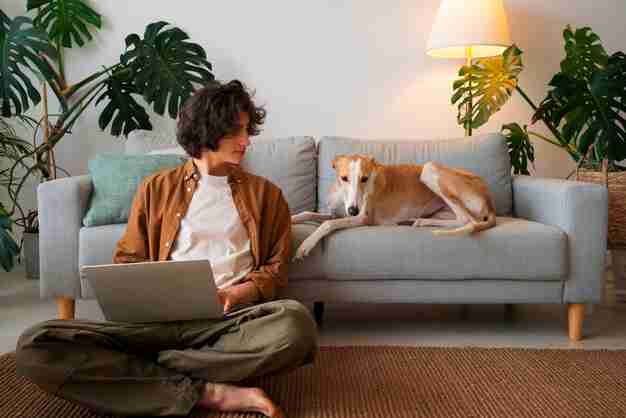Welcoming an antisocial dog into your home can be a rewarding yet challenging experience. These dogs, often fearful or anxious in social situations, require a unique environment that fosters trust and security. By making thoughtful adjustments and providing the right support, you can help your new furry friend feel comfortable and gradually overcome their fears.
In this comprehensive guide, we will explore practical strategies and tips on how to prepare your home for an antisocial dog, ensuring they have a safe haven where they can thrive.
Understanding Your Dog’s Needs:
Before making any changes, it’s crucial to look out for signs dog is antisocial. These dogs usually don’y know what love means. Make sure to understand your dog’s specific triggers and comfort zones. Observe their behavior closely, noting situations that cause stress or fear. Recognizing their boundaries will guide your efforts in creating a tailored and supportive environment.
1. Designating a Safe Space
Creating a designated safe space for your antisocial dog is paramount in providing them with a sanctuary where they can feel secure and relaxed. Choose a quiet corner in your home, away from the hustle and bustle of everyday activities. This area should be shielded from high-traffic areas, loud noises, and sudden movements. The idea is to minimize stimuli that could trigger anxiety.
Consider investing in a cozy dog bed from Pethood that’s made of soft, comforting materials. Add layers of blankets, providing warmth and a sense of security. Introduce familiar toys that your dog loves, offering them a source of comfort and entertainment. Ensuring this space is peaceful and inviting helps your dog associate it with positive experiences, encouraging them to retreat there when they feel overwhelmed.
Dogs, like humans, benefit greatly from having a personal space where they can retreat when feeling stressed. Providing a dedicated area not only offers a physical retreat but also mentally reassures your dog, fostering a sense of safety. Over time, your dog will associate this space with calmness, making it an essential element in helping them cope with their anxieties.
2. Creating a Calm Atmosphere
Maintain a serene atmosphere in your home by minimizing loud noises and sudden movements. Consider using soft lighting and calming background music to create a soothing ambiance. Creating a serene atmosphere at home not only reduces stress but also facilitates a positive state of mind for your dog. Soft lighting and calming music contribute to a sense of security, aiding your dog in feeling more at ease. Additionally, controlled social interactions empower your dog, enabling them to build confidence gradually, thus enhancing their overall sociability. Avoid inviting too many guests or strangers into your home initially, allowing your dog to adjust at their own pace.
3.Implementing Regular Routines:
Establishing consistent daily routines is like providing a roadmap for your antisocial dog, offering them a sense of stability and security. Dogs, especially those prone to anxiety, thrive on predictability. Set regular feeding times, ensuring they have nutritious meals to support their physical health. Schedule daily walks and playtime sessions, incorporating physical activities that align with their comfort level.
Predictability not only provides a sense of security but also helps manage your dog’s expectations. Knowing when to anticipate meals, walks, and playtime reduces anxiety by creating a structured daily rhythm. Regular routines also contribute to your dog’s overall well-being, ensuring they receive adequate exercise, mental stimulation, and opportunities for positive interactions.
4. Secure Fencing and Gates
If you have a yard, ensure that your fencing is secure and tall enough to prevent escape. Antisocial dogs may attempt to run away when faced with unfamiliar situations. Regularly inspect the fencing for any gaps or weak points, reinforcing them promptly. Consider using baby gates indoors to create safe spaces and limit access to certain areas of the house.
5. Gentle Introduction to Other Pets
If you have other pets, introduce them to your new antisocial dog gradually and in a controlled manner. Use positive reinforcement techniques to encourage peaceful coexistence. Monitor their interactions closely and intervene if tensions arise. With time, supervised interactions can help build positive relationships between pets.
Introducing a new dog to your existing pets is a delicate process that demands careful attention to their behaviors and responses. Every pet has a unique personality and temperament, making it essential to be attuned to their cues during introductions.
Patience is key; rushing these interactions can create stress and potentially lead to conflicts. By utilizing positive reinforcement and gradual introductions, you pave the way for positive relationships, fostering an environment where your pets can coexist peacefully. These initial interactions set the tone for their future interactions, emphasizing the importance of a patient and positive approach in nurturing camaraderie among your furry family members.
6. Positive Reinforcement Training:
Implement positive reinforcement training techniques to encourage desired behaviors. Use treats, praise, and rewards to reinforce calm and sociable actions. Training not only helps in managing their behavior but also boosts their confidence and trust in you as their caregiver.
Positive reinforcement training goes beyond shaping behavior; it’s a transformative journey that enhances your dog’s confidence and trust in you. Through this method, you become a source of encouragement and security for your antisocial dog. The rewards they receive, whether in the form of treats or praise, become symbols of your approval and love. This positive association with you strengthens your bond, making your dog more receptive to social interactions and enabling them to approach new experiences with greater assurance. Positive reinforcement training is not just about teaching commands; it’s about nurturing a positive mindset and building a resilient, sociable nature in your beloved companion.
7. Consulting a Professional Trainer or Behaviorist
If your dog’s antisocial behavior persists, consider seeking help from a professional dog trainer or behaviorist. These experts can assess your dog’s specific needs and provide tailored training strategies. Their expertise can make a significant difference in helping your dog overcome their fears and socialize more comfortably.
Conclusion
Preparing your home for an antisocial dog involves creating an environment that prioritizes their emotional well-being and sense of security. By understanding their unique needs, providing a designated safe space, maintaining a calm atmosphere, and implementing positive reinforcement training, you can help your dog adapt and thrive in their new home. Patience, consistency, and love are the cornerstones of building trust and confidence in antisocial dogs, paving the way for a fulfilling and enriching companionship.






